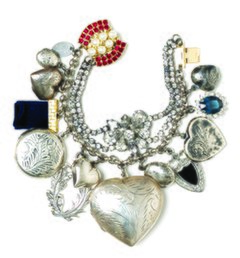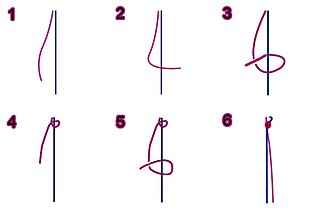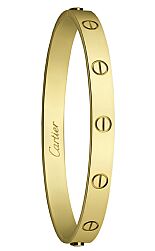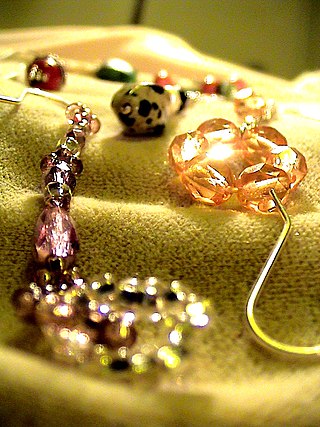
A charm bracelet is a type of bracelet which carries personal jewelled ornaments or "charms", such as decorative pendants or trinkets. The decorative charms usually carry personal or sentimental attachment by the owner.

A charm bracelet is a type of bracelet which carries personal jewelled ornaments or "charms", such as decorative pendants or trinkets. The decorative charms usually carry personal or sentimental attachment by the owner.
The wearing of charms may have begun as a form of amulet or talisman to ward off evil spirits or bad luck. [1]
During the pre-historic period, jewellery charms would be made from shells, animal-bones and clay. Later charms were made out of gems, rocks, and wood.
For instance, there is evidence from Africa that shells were used for adornments around 75,000 years ago. In Germany intricately carved mammoth tusk charms have been found from around 30,000 years ago. In ancient Egypt charms were used for identification and as symbols of faith and luck. Charms also served to identify an individual to the gods in the afterlife. [2]
During the Roman Empire, Christians would use tiny fish charms hidden in their clothing to identify themselves to other Christians. Jewish scholars of the same period would write tiny passages of Jewish law and put them in amulets round their necks to keep the law close to their heart at all times. Medieval knights wore charms for protection in battle. Charms also were worn in the Middle Ages to denote family origin and religious and political convictions.
Charm bracelets have been the subject of several waves of trends. The first charm bracelets were worn by Assyrians, Babylonians, Persians, and Hittites and began appearing from 600 – 400 BC. [3]
For example, Queen Victoria wore charm bracelets that started a fashion among the European noble classes. She was instrumental to the popularity of charm bracelets, as she “loved to wear and give charm bracelets. When her beloved Prince Albert died, she even made “mourning” charms popular; lockets of hair from the deceased, miniature portraits of the deceased, charm bracelets carved in jet.”[ citation needed ]

In 1889, Tiffany and Co. introduced their first charm bracelet — a link bracelet with a single heart dangling from it, a bracelet which is an iconic symbol for Tiffany today.[ citation needed ]
Despite the Great Depression, during the 1920s and 1930s platinum and diamonds were introduced to charm bracelet manufacturing.
Soldiers returning home after World War II brought home trinkets made by craftsmen local to the area where they were fighting to give to loved ones. American teenagers in the 1950s and early 1960s collected charms to record the events in their lives. Screen icons like Elizabeth Taylor and Joan Crawford helped to fuel the interest and popularity of charm bracelets. [4]
Although interest and production waned through the latter part of the 20th century, there was a resurgence of popularity after 2000 and collectors eagerly sought out vintage charms. Inspired by the movie Pirates of the Caribbean , bracelets with little charms of swords, crosses and skulls were introduced as a fashion trend during winter 2006.

An Italian Charm bracelet, also known in the USA as a Nomination bracelet, is a series of individual modular links hooked together on a stretchy band to form a single charm bracelet. A typical Italian charm bracelet comprises eighteen charm links. Each link features a charming face (design or image) soldered onto the actual charm link.
In 1987, an Italian jewelry company Nomination, based in Sesto Fiorentino, Italy, introduced the Composable line, featuring modular bracelets made of stainless steel. It had later become known as the “Italian charm bracelets”. People would add links to update their bracelets with symbols that told the story of the important events, milestones, and achievements in their lives, as well as hobbies and goals. [5] [6] In the 1990s, American tourists noticed the style and brought it to the United States. [7] And in the late ‘90s and early 2000s, Italian charm bracelets became popularized in the US. [8]
By 2023, Italian charm bracelets reclaimed popularity, notably adorned by "Love Island" Season 9's Anna-May Robey and creating buzz on TikTok. [9] [10] [11]
Nomination stood out for its customizable bracelets, composed of modular charms that snugly interconnect, akin to a stretch band, lying flat on the wrist. These pieces, often crafted from stainless steel and adorned with materials like 18k gold, 9k gold, 925 silver, and an array of gemstones, catered mainly to young women, though men's models were also available. [12]

Costume or fashion jewelry includes a range of decorative items worn for personal adornment that are manufactured as less expensive ornamentation to complement a particular fashionable outfit or garment as opposed to "real" (fine) jewelry, which is more costly and which may be regarded primarily as collectibles, keepsakes, or investments. From the outset, costume jewelry — also known as fashion jewelry — paralleled the styles of its more precious fine counterparts.

Jewellery consists of decorative items worn for personal adornment, such as brooches, rings, necklaces, earrings, pendants, bracelets, and cufflinks. Jewellery may be attached to the body or the clothes. From a western perspective, the term is restricted to durable ornaments, excluding flowers for example. For many centuries metal such as gold often combined with gemstones, has been the normal material for jewellery, but other materials such as glass, shells and other plant materials may be used.

A pendant is a loose-hanging piece of jewellery, generally attached by a small loop to a necklace, which may be known as a "pendant necklace". A pendant earring is an earring with a piece hanging down. Its name stems from the Latin word pendere and Old French word pendr, both of which translate to "to hang down". In modern French, pendant is the gerund form of pendre and also means "during". The extent to which the design of a pendant can be incorporated into an overall necklace makes it not always accurate to treat them as separate items.

A necklace is an article of jewellery that is worn around the neck. Necklaces may have been one of the earliest types of adornment worn by humans. They often serve ceremonial, religious, magical, or funerary purposes and are also used as symbols of wealth and status, given that they are commonly made of precious metals and stones.

A bracelet is an article of jewellery that is worn around the wrist. Bracelets may serve different uses, such as being worn as an ornament. When worn as ornaments, bracelets may have a supportive function to hold other items of decoration, such as charms. Medical and identity information are marked on some bracelets, such as allergy bracelets, hospital patient-identification tags, and bracelet tags for newborn babies. Bracelets may be worn to signify a certain phenomenon, such as breast cancer awareness, or for religious/cultural purposes.

A brooch is a decorative jewelry item designed to be attached to garments, often to fasten them together. It is usually made of metal, often silver or gold or some other material. Brooches are frequently decorated with enamel or with gemstones and may be solely for ornament or serve a practical function as a clothes fastener. The earliest known brooches are from the Bronze Age. As fashions in brooches changed rather quickly, they are important chronological indicators. In archaeology, ancient European brooches are usually referred to by the Latin term fibula.

Cufflinks are items of jewelry that are used to secure the cuffs of dress shirts. Cufflinks can be manufactured from a variety of different materials, such as glass, stone, leather, metal, precious metal or combinations of these. Securing of the cufflinks is usually achieved via toggles or reverses based on the design of the front section, which can be folded into position. There are also variants with chains or a rigid, bent rear section. The front sections of the cufflinks can be decorated with gemstones, inlays, inset material or enamel and designed in two or three-dimensional forms.

A parure is a set of various items of matching jewelry, which rose to popularity in early 19th-century Europe.

An Italian Charm bracelet, also known in the US as a Nomination bracelet, is a series of individual modular links hooked together on a stretchy band to form a single charm bracelet. A typical Italian charm bracelet comprises eighteen charm links. Each link features a charming face soldered onto the actual charm link.

A friendship bracelet is a decorative bracelet given by one person to another as a symbol of friendship. Friendship bracelets are often handmade, usually of embroidery floss or thread and are a type of macramé. There are various styles and patterns, but most are based on the same simple half-hitch knot. They resemble a friendship that is strong and everlasting.

Blackamoor is a type of figure/visual trope in European decorative art, typically found in works from the Early Modern period, depicting a man of sub-Saharan African descent, usually in clothing that suggests high status. Common examples of items and objects decorated in the blackamoor style include sculpture, jewellery, and furniture. Typically the sculpted figures carried something, such as candles or a tray. They were thus an exotic and lightweight variant for the "atlas" in architecture and decorative arts, especially popular in the Rococo period.

Hairwork, or jewelry or artwork made of human hair, has appeared throughout the history of craft work, particularly to be used for private worship or mourning. From the Middle Ages through the early twentieth century, memorial hair jewelry remained common. Hair, considered to be a remnant off the person it was cut from, also has often played a part in myths and legends; in a Swedish book of proverbs, one can read that “rings and bracelets of hair increase love”. One example can be found in Denmark, at Rosensborg’s palace, which is a bracelet of precious metal with a simple braided lock of hair - a gift from King Christian IV (1577-1648) to his queen. Another example would be the rings commemorating the execution of King Charles I of England (1600-1649), which circulated among his faithful supporters. Other famous people who owned hair jewelry include Napoleon, Admiral Nelson, Queen Victoria and her large family, Christina Nilsson and Jenny Lind.

The Love Bracelet is a piece of jewelry designed in 1969 by Aldo Cipullo and offered to Cartier SA. Early versions of the Love Bracelet featured gold plating, while more recent designs are created from solid gold or platinum. Prices for the bracelets differ depending on the item's materials. As of 2019, the Love Bracelet is still in production and Cartier has expanded the line to include products based on the original bracelet's design, including cufflinks, rings, earrings, necklaces, and watches. In 2006 the line was considered to be the "most successful collection in Cartier's history."

A bijou from the French bijou is an intricate jewellery piece incorporated into clothing, or worn by itself on the body.
Daisy London is a British jewellery brand founded in 2009. It has an e-commerce platform and distributor in UK and internationally.

TikTok, whose mainland Chinese counterpart is Douyin, is a short-form video hosting service owned by ByteDance. It hosts user-submitted videos, which can range in duration from 3 seconds to 10 minutes.
Lego DOTS is a Lego theme based on multiple shapes and colourful tiles, with 1×1 elements intended to decorate the products. These include wearable wristbands and decorative room objects that can be individually customised. The theme includes over 30 mood tiles including facial expressions, a music note, a cosmic planet, star night and paw print. The theme was first introduced in March 2020. In January 2023, The Lego Group announced Lego DOTS will be discontinued in December 2023.
An Internet aesthetic, also simply referred to as an aesthetic, is a visual art style, sometimes accompanied by a fashion style, subculture, or music genre, that usually originates from the Internet or is popularized thereon. Throughout the 2010s and 2020s, online aesthetics gained increasing popularity, specifically on social media platforms such as Tumblr, Pinterest, Instagram and TikTok. The term aesthetic has been described as being "totally divorced from its academic origins", and is commonly used as an adjective.

Yingluo is a ring-shaped neck ornament or fashion jewellery of Buddhist origins in ancient China with its earliest prototypes having roots in ancient India. In China, the yingluo was first used as a Buddhist ornament in Buddhist decorative arts, including sculptures and paintings such as the Dunhuang frescoes. The yingluo depicted as decorative Buddhist art elements and was later imitated and turned into an actual elegant necklace by the Tang dynasty. It was then widely adopted as a classical necklace in Chinese society for centuries and as a head-wear. It was also used the hanfu of Chinese women where it was used as a neck ornament or jewellery, and was especially favoured by the Chinese court ladies in ancient times. The yingluo could also be used as a textile pattern which would applied on Chinese clothing. The yingluo gradually lost popularity as it lost its appeal due to the changes in people's sense of aesthetic and aesthetic needs in modern times. However, it currently continues to be worn as a common modern-day hanfu accessory by Hanfu enthusiasts since the Hanfu movement and can appear in various styles and materials.
![]() Media related to Charm bracelets at Wikimedia Commons
Media related to Charm bracelets at Wikimedia Commons